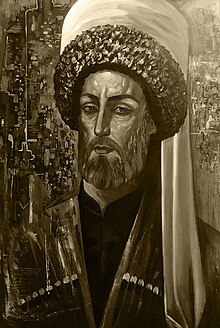|
Sheikh Mansur
Sheikh Mansur ("The-Victorious"; born Mansur Ushurma, Mansur Ucherman; c. 1760 – 13 April 1794) was a Chechen military commander and Islamic leader who led an anti-Russian North Caucasian resistance, known as the Sheikh Mansur Movement. He was influential in the resistance against Catherine the Great's imperialist expansion into the Caucasus during the late 18th century. Sheikh Mansur is considered the first leader of the resistance in the North Caucasus against Russian imperialism. He remains a hero of the Chechen and North Caucasian peoples in general, and their struggle for independence.[1] BiographyMansur Ushurma was born in the aul of Aldi (today a suburb of Grozny) in the region of Chechnya, centered in the Sunzha River valley. Later on, he ventured to the Dagestan hill country for education, eventually settling for a madrasa.[2]: 56 In 1784, Sheikh Mansur, now a respected imam, journeyed back to Chechnya and became upset with the Russian encroachment in the North Caucasus. He ordered the remaining non-Muslim Chechens to stop practicing many of their old pagan traditions with the cult of the dead and to stop smoking tobacco and drinking alcohol. He also influenced Islamic concepts into social conventions (adat) and preached them to attempt Islamic unity. This was not easy in a land where people had lived under ancient traditions, customs and religions. Islamic tradition in Chechnya, especially in the mountainous areas, was not as strong as it was in Dagestan. But the holy war that he declared was an attempt at unity among the Chechen teips. As Mansur's message became popular with the Chechen people, the Russian Empire attempted to discredit him and ultimately arrest him. In 1785, the Russians sent a punitive expedition of up to 3,000 to his home in Aldi, only to find the village bare and desolate. Angered, the Russian troops plundered and burned the village to the ground. Upon returning to Aldi with others, Mansur proclaimed a holy war (gazavat) against the Russians. Soon, Chechen fighters won the Battle of Aldy, killing and taking hundreds of Russian soldiers captive.[2]: 57 [3] After that, Sheikh Mansur rallied resistance fighters from Dagestan through Kabardia. Most of the forces were young Chechen and Dagestani men numbering more than 12,000 by August 1785. However, Mansur suffered several defeats when he tried to infiltrate Russian territory and capture the fortresses Kizlyar in July, Grigoriopolis and Kizlyar again in August 1785. The core of the Mansur's troops consisted of the Kumyks from the Northern parts of Kumykia.[4] Kumyk princes participated in the first attack on the Russian garrison in Kizlyar, led by Sheikh Mansur. Those princes were Chapalav Anji-Murtazali, Makhach Uruskhan, Hamza Alish, along with their uzdens (suite of nobles). The Kumyks made a decision that:[5]
After the battle of Kizlyar, the Russian people refortified their settlements and the Russian Empress Catherine the Great withdrew her forces from Georgia to the Terek River line. In 1786, Russian forces abandoned the new fort of Vladikavkaz, and would not occupy it again until 1803. From 1787 to 1791, during the Russian-Turkish War, Sheikh Mansur moved to the northwestern Caucasus region of Circassia, strengthening Islamic practice there. He led the Circassians and Nogais in assaults against Russian forces. In June 1791, Sheikh Mansur was captured at the Ottoman fortress of Anapa on the Black Sea when it came under siege. He was brought to Saint Petersburg and imprisoned for life. In April 1794, he died at the Shlisselburg Fortress. AppearanceDescription by Russian historian Prozitelev:[6]
Description by the 3rd Imam of the Caucasian Imamate Imam Shamil:[6]
Legacy
See alsoReferences
|
||||||||||||||
